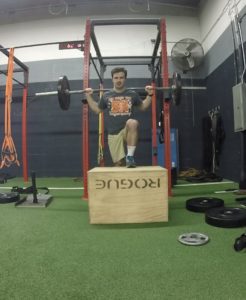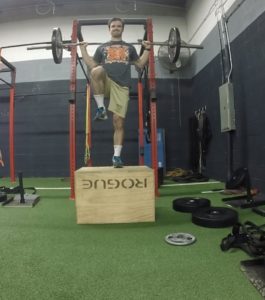The application of strength in endurance events and how to program strength-training into running programs
Dr. Andy Boyce – Your Downers Grove Chiropractor
Strength is often a misinterpreted quality when considering its relation to different sports.
When people hear strength, they think of big and strong power lifters, strongmen, linebackers, or the jacked Crossfitters who seem to be good at everything that involves picking up a barbell.
While it’s true that ALL of these sports do require significant amounts of strength, the function of strength is often overlooked when looking at endurance sports such as running and cycling.
This to the detriment of many runners and cyclists performance.
Let’s take a deeper look.
Definition of Strength
First, we need to look at what the actual definition of strength is before we go any further.
Strength can be defined as the ability to apply force against an external load. Going a little deeper, we can define force by Newton’s 2nd law, Force= Mass x Acceleration.
Simple algebra tells us that in order to increase the amount of force generated, we need to do one of two things, increase the mass we are moving (adding more weight on the bar), or increase the rate of speed of the object we are moving, this can be a barbell or our bodies against gravity.
Utilizing Newtons 2nd law throughout training programs is a way to consistently generate high amounts of force without constantly being under a high load.
This can help moderate the amount of stress that is placed on the body, ensuring it is a beneficial type of stress (eustress) to stimulate an adaptation, and not a distress, which can lead to overtraining and injury.
This is one of the basic principles of the conjugate style of training, something that will be covered in a different post.
Physics aside, we need to go into further depth at the application of strength in the context of endurance events.
Downers Grove Runners Pay Attention
Lets look at runners as our example.
We can define endurance events as repeated submaximal contractions of a muscle over an extended period of time.
In the case of running, this means all the muscles involved in the stride are generating submaximal amounts of force every single stride.
So, over the course of a marathon the muscles responsible for moving the legs might be contracting at 20% of their maximal force output.
The muscles will contract submaximally over the course of the race, increasing the force of contraction during surges or during the final kick of the race.
Improvements in strength don’t change the fact that endurance challenges are repeated submaximal contractions over an extended period of time, but it does make that 20% of maximal contraction more forceful each and every stride.
This improvement in strength leads to improved speed, conservation of much needed energy, and an increase in mechanical efficiency.
Improvements in strength also play a role in decreasing injury risk on two different levels.
Firstly, stronger people are more hardy and resilient, it takes more for them to get hurt.
Two important things to consider while programming strength training for runners is that it improves tendon strength and bone density, two things that are often hurt during the course of a running program in the case of runners knee and stress fractures.
Adding strength training to a running program also helps decrease injury risk by decreasing the amount of total mileage runners have in their program, which is quite often the reason for pain, injuries, and stagnation.
Contemporary training plans tend to overemphasize specificity part of the the SAID principle, or the specific adaptation to imposed demands.
This means the body will adapt in a way to best handle the stress that was imposed on it in the future.
For example, if someone practices benching heavy weight, odds are they will improve in their ability to bench heavy weight.
Likewise, if we practice piano, we would like see an increase in our ability to play the piano.
Running programs tend to overemphasize the specificity part in that they have their athletes run far too much during programs, leaving no time for alternative training to improve other areas of weakness.
Not only does the excessive miles commonly lead to overtraining, injury, and eventual stagnation, but it completely ignores the fact that getting stronger (to a point) is bound to help performance.
Replacing the junk miles, or the days when runners just go for a run to meet their quota for the week, is a great place to substitute days where we lift weights.
Downers Grove Runners – Let’s Talk About Junk Miles
Anyone who has trained for a race knows what the junk miles are.
They are the miles that we plod through just because they were written into our plan we “need to get a run in”.
These are some of the silliest miles people run, they don’t provide any real benefit and all they really do is add to the accumulated fatigue, increasing the risk for injury.
A better idea would be to replace those days with strength training, providing a novel stimulus to the body, improving strength, reducing injury risk, and improving overall performance.
Downers Grove
Excellent exercises to add into programs would be those that do the best job at improving overall strength.
Downers Grove Chiropractor Uses Strength Training for Runners
These would be the squat, and the deadlift.
Proper application of these exercises into running programs do an excellent job of increasing strength in the muscles that are utilized during running, such as the glutes and hamstrings.
Not forgetting the SAID principle, adding single leg work is also important to improve the bodies ability to perform on one leg.
Running is a coordinated bound from single leg to single leg with a period of floating inbetween.
If two feet are on the ground at one time, by definition it is not a run.
This definition highlights the importance of single leg work, such as the lunging motion, box-step ups, single leg RDLs, etc.
My personal favorite single leg exercise is Russian step-ups.
The extra hip flexion at the top of the lift adds an extra challenge that makes the exercise that much more fun.

Starting position for the Russian step-up

Ending position of the Russian Step-up
Downers Grove Chiropractor Says “It’s all about Programing.”
Lastly, one common error coaches who do program lifting for their runners make is the amount of load they prescribe.
Often, runners will perform these exercises in an unloaded fashion, or just against the force of gravity on their body.
This can help athletes who have never performed these motions before, but the body will quickly adapt to this stimulus and its utility will eventually expire.
Progressive increases in load, whether by weight or volume, is a tried and true way to improve upon strength, much more effectively than doing incredibly high reps of body weight squats and lunges.
The gains in strength can be achieved in a quicker and much more efficient manner under a heavier load compared to body weight exercises until failure.
If you are a runner or an athlete who is looking to improve your performance in any race distance your Downers Grove Chiropractor is here to help.
Click on the link above to schedule a free consultation.
Core1 offers chiropractic care, physical therapy, and sports performance training.
